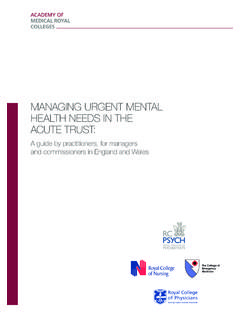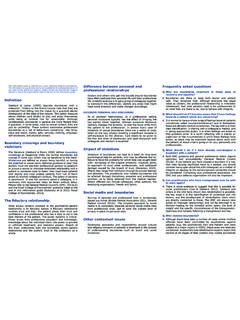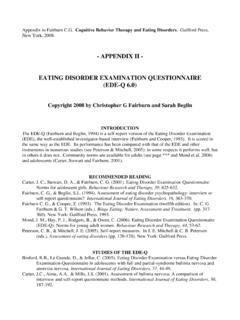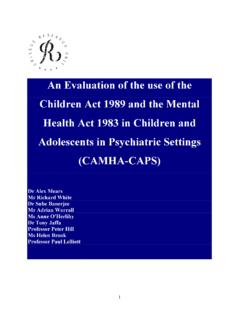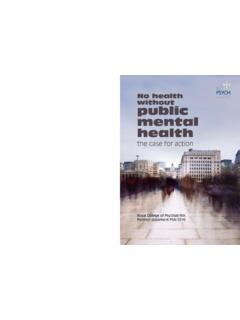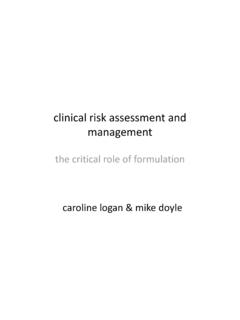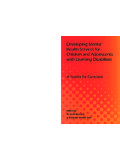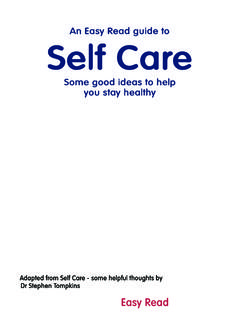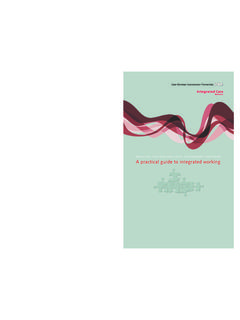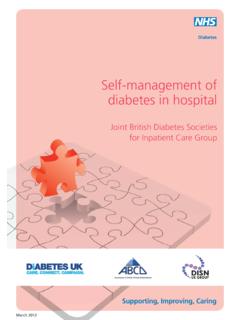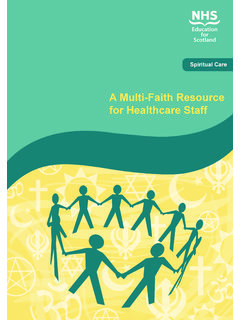Transcription of Self-harm, suicide and risk: a summary
1 self - harm , suicide and risk: a summaryPosition Statement PS3/2010 July 2010 Royal College of PsychiatristsLondonApproved by Central Policy Coordination Committee: July 2010 self - harm , suicide and risk: a summary * Position Statement June 2010 Royal College of Psychiatrists London * This Position Statement is a summary of the full College Report self - harm , suicide and risk: helping people who self - harm CR158 which is available from the Royal College of Psychiatrists Publications Department and on the College website at This also contains a full bibliography. DISCLAIMER This guidance (as updated from time to time) is for use by members of the Royal College of Psychiatrists. It sets out principles that, in the view of the College, should be followed by members. None the less, members remain responsible for regulating their own conduct in relation to the subject matter of the guidance.
2 Accordingly, to the extent permitted by applicable law, the College excludes all liability of any kind arising as a consequence, directly or indirectly, of the member either following or failing to follow the guidance. Ov e r v i e wSelf harm and suicide : A major challenge for all self harm and suicide are manifestations of emotional distress and illness which not only cause the individual, their families and friends distress and anxiety but also have a damaging impact on the economy and wider society. The current situation:The incidence of self harm in the UK has risen over the last few decades estimated at 400 per 100, of all ages and all social groups engage in self harming behaviour or kill themselves, with some groups - such as young people, veterans and prisoners - at particular risk. Many people do not have mental illness but have multiple life problems of a personal, social or economic harm and suicide need to be tackled through public health strategies and improvements in College report examines the issues of self - harm , suicide and risk in detail.
3 It was produced by a working group, chaired by Lord John Alderdice. It was compiled with the help of expert evidence from health professionals, third sector providers, policy professionals, service users and carers as well as members of the Royal College of Psychiatrists. It takes the current research picture into consideration, as well as surveys of College members and current government guidelines and initiatives. This position statement is a summary of some of the key findings and recommendations from the report. Our central theme is that the needs, care, wellbeing and individual human dilemma of the person who harms him or herself should be at the heart of what clinicians do. We must never forget, however, that we are not just dealing with social phenomena but with people who are often at, and beyond, the limit of what they can emotionally endure.
4 Their aggressive acts towards themselves can be difficult to understand and frustrating to address but this is precisely why psychiatrists need to be involved to bring clarity to the differing causes for the self -destructive ways in which people act and to assist in managing the problems for the people concerned including family, friends and professional carers, who sometimes find themselves at the end of their tether in the face of such puzzling and destructive behaviour. Public health policy also has a vital role to play and psychiatrists should not leave these crucial political and managerial decisions to those who are not professionally equipped to appreciate the complexities of self - harm and suicide . Lord John Alderdice, Chair Working Group. 1Th e Ch a l l e n g e s: Ke y Fi n d i n g sThere is a lack of resources for appropriate treatment and a patchy provision of good services for people who self -harmSurveys of people who self harm have repeatedly made it clear what kind of help they need when they have harmed themselves; however this help is frequently not availableEvidence also exists of widespread failure by NHS services to comply with the NICE Guideline on self harm .
5 As a result some people are discharged from hospital without mental state or needs being assessed, without a care plan, or without follow through to a GP or other service. Assessments are reportedly carried out using tools that have not been understanding of self harm among those who encounter it as part of their work whether in schools, residential care, community care, prisons or other settings Instances of unhelpful staff attitudes towards people who self - harm even in health servicesLack of training and support for staff who have to deal with complex and demanding situations with people who present after they have harmed themselves or attempted suicideJunior psychiatrists and other inexperienced health professionals are often left to deal with presentations of self - harm without the supervision or guidance of a senior preoccupation within the NHS of managing risk gives risk assessment too dominant a role in clinical care.
6 Which is to the detriment of a good therapeutic relationship between healthcare professionals and patients. Clinicians feel frustrated and demoralised that without support from their Trusts, they are unable to carry out the demanding work of attending properly to people who have self harmed and who need their help. The use of locally devised risk assessment tools that lack an evidence base should be , the evidence painted a bleak picture of standards of care for people who self harm in UK hospitals thus leading us to call for better training, more supervision by senior staff members and improved follow up and assessment tools. a a a a a2Th e Op pO r T u n iT i e s: re pO r T re C Om m e n d aT i O n sThis report highlights many examples of excellent best practice across the United Kingdom where dedicated staff are providing innovative and effective self - harm services.
7 These need to be built upon. Our recommendations set out what the government, NHS Trusts and commissioners, professional bodies and the third sector ought to be aiming for to improve the care for people at risk of suicide and self harming behavior. We firmly believe that the changes we propose will be cost effective in the longer term, and furthermore that many do not involve significant recommendations cover a wide range of issues including: The need for a proper public health strategy to cover self harm and for the suicide prevention strategy to remain a priority in all nations of the UKNHS services, particularly in A & E, to be managed in a way which ensures that people who have self harmed or tried to kill themselves have proper access to care and treatment by fully trained clinical staff and that the NICE Guideline on self harm is implementedA change to the culture of NHS services to address self harm so that staff who encounter people who self harm are trained and supported in this difficult work.
8 Greater recognition by the statutory sector of, and support for, the role of the third sector bodies such as the Samaritans and SANE in assisting those who are involved with self harm or are suicidalPsychiatrists, including liaison psychiatrists, need to have a full role in helping people who self harmIn contrast to suicide , research on self harm has been neglected and overlooked. Funding needs to be allocated to research on the causes and treatments of self harm . Without this people who self harm will continue not to receive the best care, whilst clinicians will still lack guidance as to what works and for whom 3in T r O d uC Ti O n self - harm is poorly understood in society and people who self - harm are often subject to stigma and hostility. Even working people who regularly encounter cases of self - harm - whether as school teachers, social workers, housing officers, police, prison officers, pastors, and even nurses or doctors - may find the care of people who have harmed themselves particularly challenging.
9 Yet, (in contrast to the trends in completed suicide ) the incidence of self - harm has continued to rise in the UK over the past 20 years and, for young people at least, is among the highest in Europe. This is a worrying situation in our society and a particular cause of concern for psychiatrists and other mental health professionals. The focus of the new College Report on self - harm is to explore why people harm and kill themselves and to consider the role (including the limits of the role) that psychiatrists and other mental health care professionals play in their care and treatment. The experiences and the views of people who harm themselves as well as those of their carers, health professionals and third sector workers are central to this enquiry. Policy and guidance on self - harm and suicide prevention is plentiful and the report does not attempt to retrace the same ground but to examine the evidence of practice on the ground, including the implementation of the NICE Guidelines on self harm .
10 Part I: Understanding the Problems and the PeopleFor the purpose of this Report we define self - harm as an intentional act of self -poisoning or self -injury irrespective of the type of motivation or degree of suicidal intent. Thus it includes suicide attempts as well as acts where little or no suicidal intent is involved (for example, where people harm themselves to reduce internal tension, distract themselves from intolerable situations, as a form of inter-personal communication of distress or other difficult feelings, or to punish themselves). An act of self - harm is a not necessarily an attempt or even indicator of intent to commit suicide , indeed it can sometimes be a form of self it covers a wide spectrum of behaviour with harmful physical effects and a person who repeatedly self -harms is at a higher risk of suicide . self - harm is a manifestation of emotional distress; an indication that something is wrong rather than a primary disorder.

